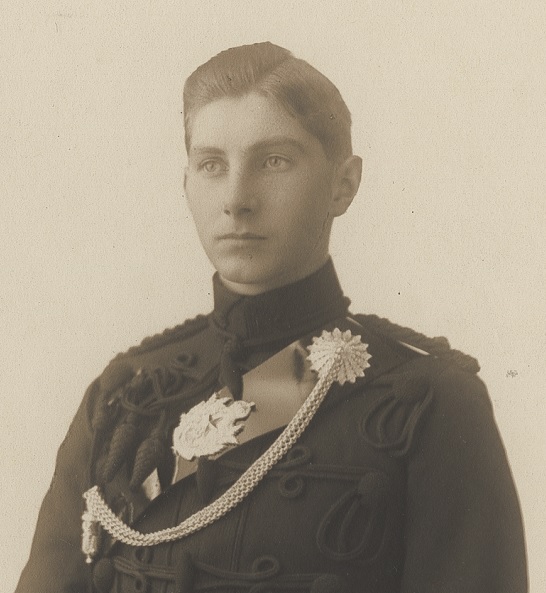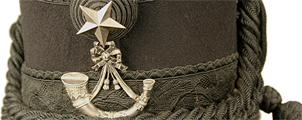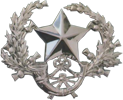The Religion of the Regiment in the Great War
Without question one of the most important topics which differentiates The Cameronians (Scottish Rifles) from other regiments is their association with the Church of Scotland and their many Presbyterian traditions. References in diaries and letters allude to the traditional posting of sentries which harks back to the regiment’s Covenanter roots. Nevertheless, to think of the regiment’s members as distinctly ‘hardcore’ Presbyterians would be to overlook the wide variety of recruits which came into the regiment during the First World War. While back in Scotland one newspaper remarked that a service for the Scottish dead from Gallipoli contained “grossly unscriptural and Popish prayer”[3], the men at the front covered a wide range of denominations. The religious denominations of the regiment do not seem to have been streamlined into one, modelling the regimental character as much as one which resembled the overall religious background of Scotland in the early twentieth century. Many Presbyterians, Roman Catholics, Anglicans, Atheists, and at least 85 Jewish soldiers are listed as having served in the regiment, with more not listing their true religion on enlistment forms.[4]

Lieutenant Charles ‘Frankie’ Rooke, a Jesuit, was the only Catholic officer of the 1st Battalion in 1914. He was killed on 19 June 1915 on a patrol near Bois Grenier.
At least one chaplain, Reverend James McShane attached to 19 Brigade (Including the 1st and 5/6th Battalions), was a Catholic Priest and would go on to be known through the pseudonym ‘Father McCabe’ in Robert Graves’ Goodbye to all that.[5] Company Sergeant-Major P. Docherty of the 5/6th Battalion described McShane as “idolised by men of every denomination who would have laid down their lives for him.”[6] Indeed Colonel Graham Chaplin, commander of the 1st Cameronians for much of the war found it extremely beneficial to have a Roman Catholic padre attached to a unit serving in a Catholic country such as France. While others had trouble bartering with the locals, McShane always managed to obtain chicken and eggs for the officer’s mess.[7]

Officers of the 1st Battalion, Cameronians (Scottish Rifles), and other regiments of the 33rd Division at the Divisional Horse Show at Cavillon, 18 July 1917. (© IWM Q 5693)
Whatever their religious background however, it was starkly evident that during everyday moments out of danger very few of the men preferred to identify with religion at all. Reverend John White, who, although assigned as a chaplain to the 5th Battalion, provided services to numerous others in 1915-16 perhaps had the best vantage point to decipher the religious devotion of the men. Callum Brown identifies this through the feeling of hopelessness and powerlessness felt by the average soldier, which chaplains interpreted as a growing connection to God.[8] However, this did not make them saints as White pointed out that;
The men enjoy a service that links them to their homes and firms up their ideals of life. I do not wish you to regard these men as stern puritans – they themselves would smile at the description – and if you think they are, you are sadly mistaken, and will, if you follow them from [church] parade, have a rude stick at some jest, or at some striking picturesque language, or it may be, you will suddenly lose sight of them as they drop into an estaminet.[9]
The church parades which the regiment attended when possible, were similar to those which had been conducted by chaplains throughout the history of the regiment, yet the reasoning behind many men’s attendance (at least those who willingly went) were mixed. One enlisted man in the 2nd battalion insisted that religious beliefs helped all ranks, and that a sermon received the day before entering the Battle of Festubert raised the morale of the whole battalion.[10] Another insisted solace found in religion was solely based on the individual upbringing of the soldier. In some cases the middle-class men would find solace in the religious traditions of the regiments, but many others claimed it was of no importance to them.[11] Callum Brown identifies that Scottish men as a population were declining in Church attendance, and that as part of a survey given to chaplains, only 20% of men in Scottish regiments had a “vital relationship” with the church.[12] The men who did choose to be religiously active outside of the mandated religious services found that there was a much more powerful spiritual experience to religion during the war. Sergeant Docherty watched as Padre McShane went around the entirety of 19 Brigade before their attack on High Wood on the Somme and called upon all Roman Catholics to attend a service:[13]
I am roman catholic myself, and it was the shortest and most impressive little service that I’ll ever attend. It is unforgettable and ever present in my mind. The shell-torn ground, Death Valley down below, the German shells landing intermittently on the road through the valley, and the whole Brigade looking on at about 300 men kneeling down to receive absolution before going into the battle from which the majority were fated never to return.[14]

Member of the 5th Scottish Rifles in graveyard, Spring of 1915. (Low Parks Museum CAM 2013.129)
[3] James Lachlan Macleod, “‘Greater Love Hath No Man Than This’: Scotland’s Conflicting Religious Responses to Death in the Great War,” Scottish Historical Review 81, no. 1 (April 2002): 95, doi:10.3366/shr.2002.81.1.70.
[4] Michael Adler and Max R. G. Freeman, British Jewry Book of Honour (Surrey St.: Caxton, 1922), 316-317.
[5] Robert Graves, Good-bye to all that (Anchor, 1929).
[6] Docherty, P., CSM. “5th Battalion Reminiscences Part II.” The Covenantor, Regimental Magazine of the Cameronians (Scottish Rifles), January 1936.
[7] Andrew Davidson, The Invisible Cross (London: Quercus, 2016), 288.
[8] Callum G. Brown, “Piety, Gender and War in Scotland in the 1910s,” in Scotland and the Great War, ed. Catriona Macdonald and E. W. McFarland (Edinburgh: John Donald, 1999), 180.
[9] John White, Rev., With the Cameronians (Scottish Rifles) in France: leaves from a chaplain’s diary (Glasgow: J. Smith, 1917), 57.
[10] Baynes., 203.
[11] Ibid
[12] Brown., 176.
[13] At the time 19 Brigade included the 1st Cameronians, 5th Scottish Rifles, 2nd Royal Welsh Fusiliers, and the 20th Royal Fusiliers.
[14] Docherty Part II.,
Comments: 1


